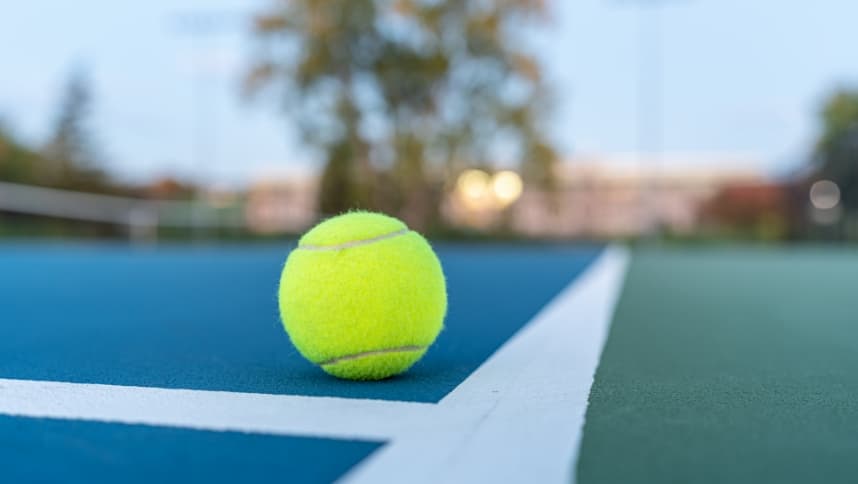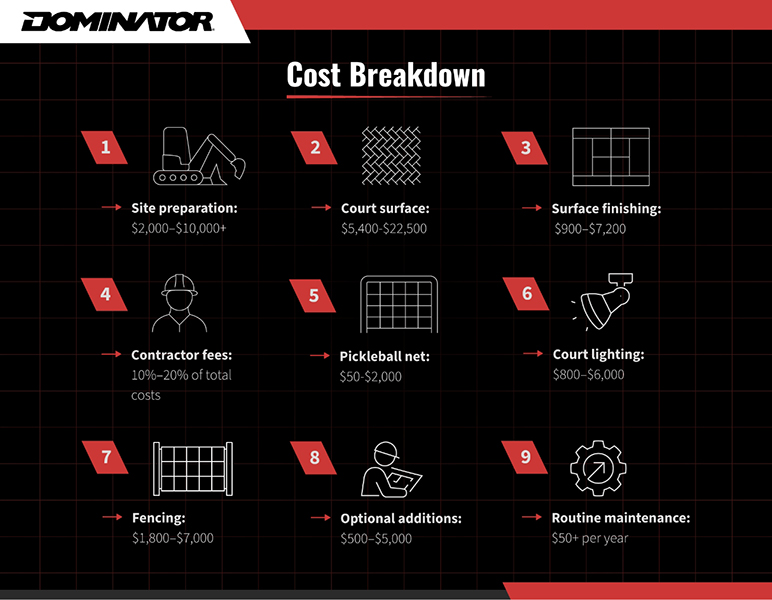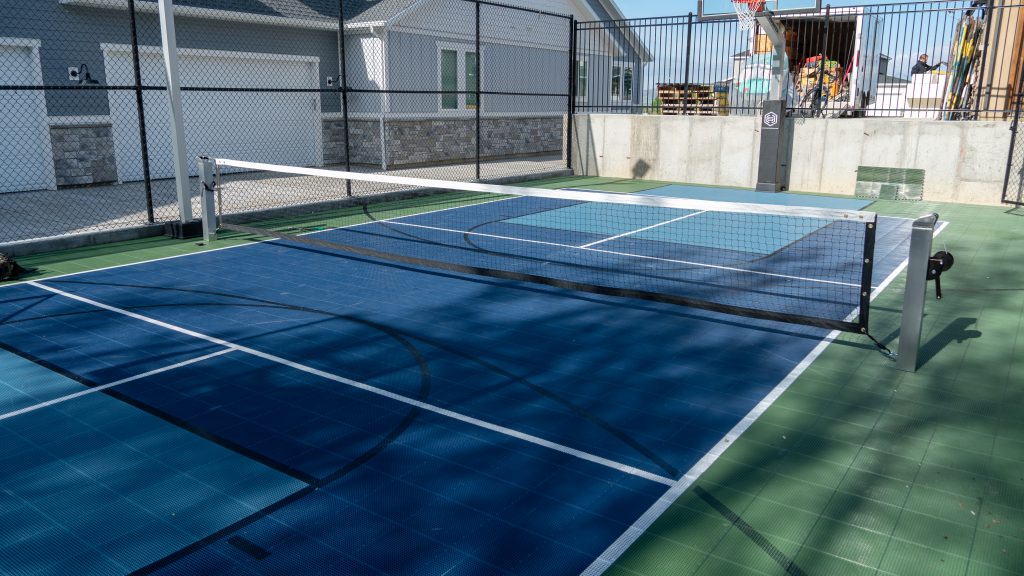Pickleball
How To Build A Pickleball Court And How Much It Costs
How To Build A Pickleball Court Outdoors
If you’ve been inspired to take your practice pickleball sessions to a new level by installing a court, you’re in luck! We’ll take you through everything you need to know about how to build a pickleball court. We’ll talk about materials, types, costs, and maintenance to make the best backyard court.

1) Determine How Much Space You Need
The first step in installing a pickleball court is determining how much space you’ll need and what type of surface material you want. Figuring out this information is going to be critical to building a court suitable for all participants and convenient for the sport. To get started, consider the following:
Type of Surface
You can play pickleball on multiple surfaces, including clay, concrete, and asphalt. Each has its benefits. Ideally, you’ll want something that requires little maintenance and minimizes impact on a player’s body.
Also, consider how much you’re willing to spend on both construction and maintenance costs. As you’ll read later on, some surface materials require more maintenance than others.
Pickleball Court Dimensions
A standard pickleball court is 20 by 44 feet, which is about the same size as a doubled badminton court. The same length applies regardless of whether you’re playing singles or doubles. However, the exact dimensions will vary depending on how many courts you plan to build. A single court, on the other hand, should have the following measurements:
- Net Height: Your net should be 36 inches high at the sidelines and 34 inches in the middle.
- Pickleball Playing Area: The standard recommendation is 30 by 60 feet. The playing area will vary depending on whether or not it’s a standalone court. Don’t forget to consider the amount of space your players need to move around.
If you plan to build multiple courts, you’ll need larger dimensions and multiple fences with padding between each court. The padding helps minimize the buildup of mildew and fungus.

2) Select a Pickleball Court Surface Type
Concrete
Pros: Concrete is durable and long-lasting. The material is firm and requires little maintenance. Because of its firm base, the ball bounces easily, making it a desirable choice for players.
Cons: Raw concrete can be problematic because it exerts extra force on a player’s body. Additionally, raw concrete material cracks easily. To avoid this concern, make sure you apply polyurethane for resistance against cracks.
Asphalt
Pros: Like concrete, asphalt is durable. Additionally, asphalt courts can easily cover large areas and are faster to build. If you’re building an outdoor court, asphalt is a popular choice because it can withstand harsh weather-related conditions and dry quickly.
Cons: They require more maintenance—you’ll need to be on top of maintenance to keep your court smooth. Plus, asphalt can inflict pain on your joints because of its hard surface, though it has more give than concrete.
Clay
Pros: Clay surface material is composed of a loose, crushed stone that makes it easier for your knees and feet to withstand force and impact. Clay also absorbs more moisture than heat, which means the surface stays cooler in warm weather.
Cons: Clay does have drawbacks, and ball performance is one of them. The bounces are irregular, so it is difficult to determine where the ball will go. Clay also requires more maintenance than other types.
Modular Sports Tile
Pros: Modular sports tiles are designed for optimal performance and comfort, providing a cushioned surface that reduces impact on players’ joints. They’re highly durable, weather-resistant, and don’t require extensive maintenance. The tiles can be easily replaced if damaged as they simply snap together, saving time and money on repairs.
Cons: Modular tiles can be more expensive upfront than basic concrete, especially for high-quality, specialized sports tiles. Sports tile require periodic cleaning to maintain traction and prevent dirt buildup between tiles. Also, some players may find that the bounce differs slightly from harder surfaces like concrete.

3) Obtain the Necessary Tools and Equipment
Pickleball Net
The next step is finding the perfect net for your court. Make sure you look for one that has adjustable heights and durable material, as it should last against all sorts of weather conditions.
When choosing a net, look for a durable one with a center strap to maintain the correct height in the middle. The top edge of the net should be adorned with a 2-inch wide white binding over its full length. The net posts should be set 12 feet apart and 1 foot outside each sideline, giving you an overall width of 22 feet.
Once you’ve found the right one, simply place it in the center of the court, following manufacturer’s instructions.
With the right pickleball net, you can easily divide your court and set proper parameters. Consider durable, rust-proof, water-resistant nets like our Dominator Rolling Portable Net. Installation is quick and easy!
Alternatively, you can opt for our hoop-to-light pickleball net. Not only do you get hardware that is stainless steel, but it is also water resistant, like our rolling portable net.
Finally, you’ll need separate posts so you can easily remove them. With our Heavy-Duty Inground Pickleball System, you get a lifetime warranty. Our offer also comes with a crank system that provides adjustable tension for your net.
Shop Pickleball Products
Pickleball Lighting
If you’re an avid player and planning to play beyond daylight hours, consider installing outdoor sports lighting. You want your matches to be well lit to avoid mishaps or mistaken out-of-bounds calls.
LED light products are solid choices if you want energy-efficient sources that can supply sufficient illumination. Luckily, we offer different LED Dominator light products.
Pickleball Fencing
While this is optional, a fence keeps your ball from rolling into unwanted areas. Make sure your fence reaches at least 10 feet to keep the ball in your court. For padded fence types, four feet should be enough.
Customization
Remember that this is YOUR court. Feel free to add personal touches. Consider options such as a score board, seating for spectators, a shade structure, or even a water cooler station for hot summer days.
Find an InstallerEquipment
As for the equipment, investing in good quality pickleball paddles can make a world of difference to your game. Today, paddles come in a variety of materials with different weights and grip sizes, so you can find one that fits your playing style. Don’t forget about the balls! Pickleball balls are designed with holes and are specific for outdoor or indoor play. Make sure you choose the right one for your court.

4) Prepare Your Pickleball Court: 4 Steps

Here are the step-by-step basics of setting up your pickleball court:
- Select a location: Find a flat, level area with dimensions that are at least 20 feet by 44 feet—since the court itself needs to be this size, allow a little extra space for fencing and sidelines, if possible.
- Make sure to consider:
- Court orientation
- Clearing the area
- Drainage
- Grading the court
- Make sure to consider:
- Gather additional materials: Besides the ones we discussed earlier, you’ll need a measuring tape, chalk, and a ruler.
- Establish court dimensions: Use your tape and chalk to mark the exact length and width of your court. Draw lines that are parallel to the centerline on both sides, and make sure they are 15 by 10 feet on either side of the centerline
- Install your net and lay down the foundation of your court with your chosen material: Remember, your nets should be 36 inches above the ground and 34 inches in the middle.
Should You Build a Court Yourself or Hire a Contractor?
That depends. If you are highly skilled when it comes to building pickleball courts, you may be able to complete the process yourself.
You’ll be saving a lot of money if you avoid professional help. However, if you are inexperienced, you could end up spending more money if something goes wrong.
A contractor can help you avoid unnecessary costs associated with equipment and materials. They also understand the structure and the layout process to build a durable court.
Find an InstallerCan You Build a Pickleball Court in Your Backyard?
If you’re wondering how to build a pickleball court in your backyard, here is what you do:
- Get the right equipment: Make sure you get paddles, nets, and balls, and follow the height recommendations we discussed in the previous section.
- Mark your lines: Use a tape measure to mark the exact dimensions you’ll need.
Install a fence: Keep your ball from going into your neighbor’s yard by installing a small fence around your court.
5) Maintain Your Pickleball Court
Cleaning
Check your court occasionally for any debris, dirt, or unwanted material that could present a problem or possibly pose a risk for injuries. Use a broom to sweep up any trash and leaves. You can also shorten the cleaning time by using a leaf blower.
Weather Protection
You’ll have to deal with occasional thunderstorms from time to time. Patch your surface if water puddles are deeper than 1/16 of an inch. If you live in an area susceptible to freezing conditions, examine any cracks since ice can exacerbate the problem.
If you’ve chosen a hard surface court like asphalt or concrete, consider resealing or repainting the surface every few years to keep it fresh and vibrant.
Line, Net, and Post Maintenance
Use warm water and detergent to clean your lines, net, and court posts thoroughly. How can you tell if your lines are in good condition? Check for any fading or stains, and check your posts for mildew, rust, and corrosion.
How Much Does It Cost to Build a Pickleball Court?
Pickleball Court Cost Breakdown
We know you want a clear answer, but the truth is every court will have a different cost. The best estimate we can give you is the average cost of building a pickleball court is between $25,000 to $50,000. It could cost as low as $10,000 if you only use essential features.
The cost of building a pickleball court can vary based on factors like the following:
- Court site preparation
- Court and surrounding pad size
- Surface type
- Contractor fees
- Lighting and fencing
- Additional features
- Routine maintenance

Court Surface Type
Your pickleball court has a few surface options with different price tags. For a 30- by 60-foot pad, you could use:
- Concrete: This most common surface type for pickleball courts ranges from $5 to $10 per square foot. A concrete surface would cost between $9,000 and $18,000.
- Asphalt: Creating an asphalt pad is slightly cheaper than concrete but less ideal because of its rough surface texture. Asphalt costs between $3 to $7 per square foot, costing you between $5,400 and $12,600.
- Clay Courts: A clay court is made of crushed earthen materials like stone. These often require more maintenance because wind and storms can wash away the material. This costs between $3.50 and $12.50 per square foot for a total cost between $6,300 and $22,500.
- Modular Tiles: Pickleball court tiles that fit together to form a court are an excellent option for seasonal courts. This construction type can range from $5,400 for a full pickleball court to tens of thousands, depending on your chosen brand.
Surface Finishing
You’ll need an acrylic top coat to finish the surface of your concrete or asphalt court. The acrylic coat provides the necessary grit, and its pop of color makes it easy to see when a ball hits the ground outside the court boundaries. Most pickleball courts are blue and green, but you can get creative here and choose unique colors.
An acrylic top coat can cost $0.50 to $1.00 per square foot. If you want an upgraded court, you can purchase cushioned acrylic mixed with granulated rubber for shock absorption. A mixed coating can cost between $2 and $4 per square foot.
Pickleball Court Materials
Your pickleball court still needs a net! A net can cost anywhere between $50 and $2,000. Portable nets are usually on the lower end of the price range and are a good option if you use the court for other purposes.
If the net is a permanent addition to your pickleball court, you may need to install permanent net posts. These could cost between $200 and $2000.
Shop Pickleball ProductsContractor Costs for Preparation
Before you begin construction, you’ll need a reliable contractor with experience building pickleball courts. Meet with them beforehand to determine the costs associated with excavation, grading, pouring cement or asphalt, painting, and installing finishing touches. These costs vary greatly based on wages in different states and individual contractors.
If you want to proceed and build it yourself, go for it! We recommend conducting research beforehand to prepare for the project and any contingencies.
Lighting and Fencing Considerations
You may want a fence around your pickleball court to stop stray balls from falling away and ensure people and pets can’t accidentally wander into your game. There are quite a few options for fencing:
- Chain Link: This costs between $9 and $30 per linear foot.
- Vinyl: This material costs between $15 and $30 per linear foot.
- Vinyl Coated: This product costs between $10 and $35 per linear foot.
- Wooden: Wood type will determine the price; a wooden fence generally costs between $12 and $27 per linear foot.
Invest in an outdoor lighting system if you intend to use your pickleball court after daylight hours. Lighting can cost anywhere from $800 to $6,000 to construct.
Routine Court Maintenance
Cleaning your court is as easy as sweeping off leaves and outdoor debris and using a hose to rinse it. If your concrete or asphalt court has surface damage, you can use acrylic putty to fill cracks or holes. Depending on the amount you need, this could cost $50 or more.
Optional Additions
You can add some comfort to your court for the final finishing touches. Remember that each of these options will add to the cost of building a pickleball court.
- Benches
- Shade
- Storage Units
- Pathways
The Cheapest Way to Build a Pickleball Court
Understanding how much it costs to build a pickleball court is essential. If you want to save money and make the most affordable pickleball court possible, here are your best options:
- Choose an area already level and clear of trees, bushes, or large rocks.
- Construct the court yourself instead of hiring someone else. This will reduce your overall costs, but if any troubles occur, it may cost extra to fix.
- Install an asphalt court, which at its cheapest would be $5,400.
- Apply the acrylic topcoat.
- Use a portable net and poles.
- Don’t install lighting.
- Don’t install a fence.
- Simplify the area around the court, and don’t add extra features like benches or shade.
The cheapest pickleball court setup you could build could cost around $10,000.
Get Started with Dominator
Before building a pickleball court, it’s vital to understand what you’re getting into. Consider all the factors we’ve mentioned (especially surface types, contractor costs, and net options) and determine a clear plan to match your needs with your budget.
We know you’ll enjoy your new pickleball court, and so will everyone else who comes to play. When you’re ready to build and need essential supplies, browse Dominator’s pickleball products and get started on your outdoor pickleball court today!
Shop Pickleball Products



















